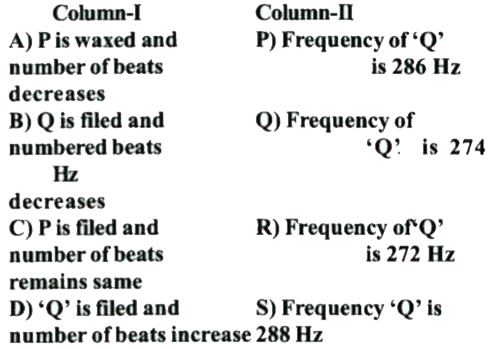A tuning fork A produces 4 beats s−1 with another tuning fork B of frequency 320Hz. ON filing one of the prongs of A, 4 beats s−1 are again heard when sounded with the same fork B. Then the frequency of the fork a before filling is
328Hz
316Hz
324Hz
320Hz
The correct Answer is:B
To solve the problem, we need to determine the frequency of tuning fork A before it was filed. Let's break down the steps:
1. Understanding Beats:
When two tuning forks produce beats, the number of beats per second (bps) is equal to the absolute difference between their frequencies. In this case, tuning fork A produces 4 beats per second with tuning fork B, which has a frequency of 320 Hz.
2. Setting Up the Equation:
The frequency of tuning fork A (let's denote it as fA) can either be:
fA=fB+4orfA=fB−4
Given that fB=320Hz, we can calculate:
- fA=320+4=324Hz
- fA=320−4=316Hz
3. Considering the Effect of Filing:
Filing one of the prongs of tuning fork A will decrease its mass, which in turn increases its frequency. This means that after filing, the frequency of A must be higher than its original frequency.
4. Analyzing the Two Cases:
- If fA=324Hz before filing, filing would increase the frequency further, leading to a larger beat frequency with fork B, which contradicts the fact that we still hear 4 beats per second.
- If fA=316Hz before filing, filing would increase the frequency, and it is possible to still have 4 beats per second with fork B (320 Hz).
5. Conclusion:
Since the only viable option that allows for 4 beats per second after filing is when the original frequency of tuning fork A was 316 Hz, we conclude that:
Frequency of tuning fork A before filing=316Hz
Final Answer:
The frequency of tuning fork A before filing is 316 Hz.
---
When two tuning forks produce beats, the number of beats per second (bps) is equal to the absolute difference between their frequencies. In this case, tuning fork A produces 4 beats per second with tuning fork B, which has a frequency of 320 Hz.
The frequency of tuning fork A (let's denote it as fA) can either be:
fA=fB+4orfA=fB−4
Given that fB=320Hz, we can calculate:
- fA=320+4=324Hz
- fA=320−4=316Hz
Filing one of the prongs of tuning fork A will decrease its mass, which in turn increases its frequency. This means that after filing, the frequency of A must be higher than its original frequency.
- If fA=324Hz before filing, filing would increase the frequency further, leading to a larger beat frequency with fork B, which contradicts the fact that we still hear 4 beats per second.
- If fA=316Hz before filing, filing would increase the frequency, and it is possible to still have 4 beats per second with fork B (320 Hz).
Since the only viable option that allows for 4 beats per second after filing is when the original frequency of tuning fork A was 316 Hz, we conclude that:
Frequency of tuning fork A before filing=316Hz
The frequency of tuning fork A before filing is 316 Hz.
Topper's Solved these Questions
- WAVESBOOK - NARAYNACHAPTER - WAVESEXERCISE - Exercise-IV
56 Videos
- WAVESBOOK - NARAYNACHAPTER - WAVESEXERCISE - Exercise-II (H.W)
17 Videos
- VECTORSBOOK - NARAYNACHAPTER - VECTORSEXERCISE - LEVEL-II (H.W)
14 Videos
- WORK , ENERGY & POWER BOOK - NARAYNACHAPTER - WORK , ENERGY & POWER EXERCISE - EXERCISE IV
43 Videos
Similar Questions
A tuning fork A produces 4 beat/s with another tuning fork B of frequency 320 Hz. On filing one of the prongs of A, 4 beat/s are again heard when sounded with the same fork B. Then, the frequency of the fork A before filing is
View SolutionA tuning fork A of frequency f gives 5 beats/s with a tuning fork B of frequency 512 Hz. If on filing A, the number of beats remains same, then find the value of f.
View Solution
Knowledge Check
A tuning fork A produces 4 beats/sec with another tuning fork B of frequency 320 Hz . On filing the fork A , 4 beats/sec are again heard. The frequency of fork A , after filing is
A324 HzB320 HzC316 HzD314 HzA tuning fork A produces 4 beats/second with another tuning fork of frequency 246 Hz. When the prongs of A are filed a little, the number of beats heard is 6 per second. What is the original frequency of the fork A?
A242 HzB240 HzC250 HzD252 HzA tuning fork X produces 4 beats/sec with a tuning fork Y of frequency 384 Hz. When the prongs of X are slightly filed 3 beats/sec are heard. What is the original frequency of X ?
A388 HzB381 HzC380 HzD387 Hz
A tuning fork A produces 5 beats/sec with another tuning fork B of frequency 256 Hz. If tuning fork A produces 1 beats/sec with some other tuning fork C of frequency 250 Hz, then calculate the frequency of fork A.
View SolutionThe prongs of the tuning fork are filed, then the frequency of the tuning fork after filing will be
View SolutionA tuning fork 'P' of frequency 280Hz produces 6 beats/s with unknown tuning fork 'Q'

View SolutionA tuning fork produces 2 beats per second when sounded with another tuning fork of frequency 250 Hz. It gives the same number of beats per second when loaded with wax. The initial frequency of 1st tuning fork is
View SolutionA tuning fork A produces 4 beats/ s with tuning fork, B of fequency 256 Hz. When the fork A is filled beats are found to occurs at shorter intervals, then the original frequency will be
View Solution
